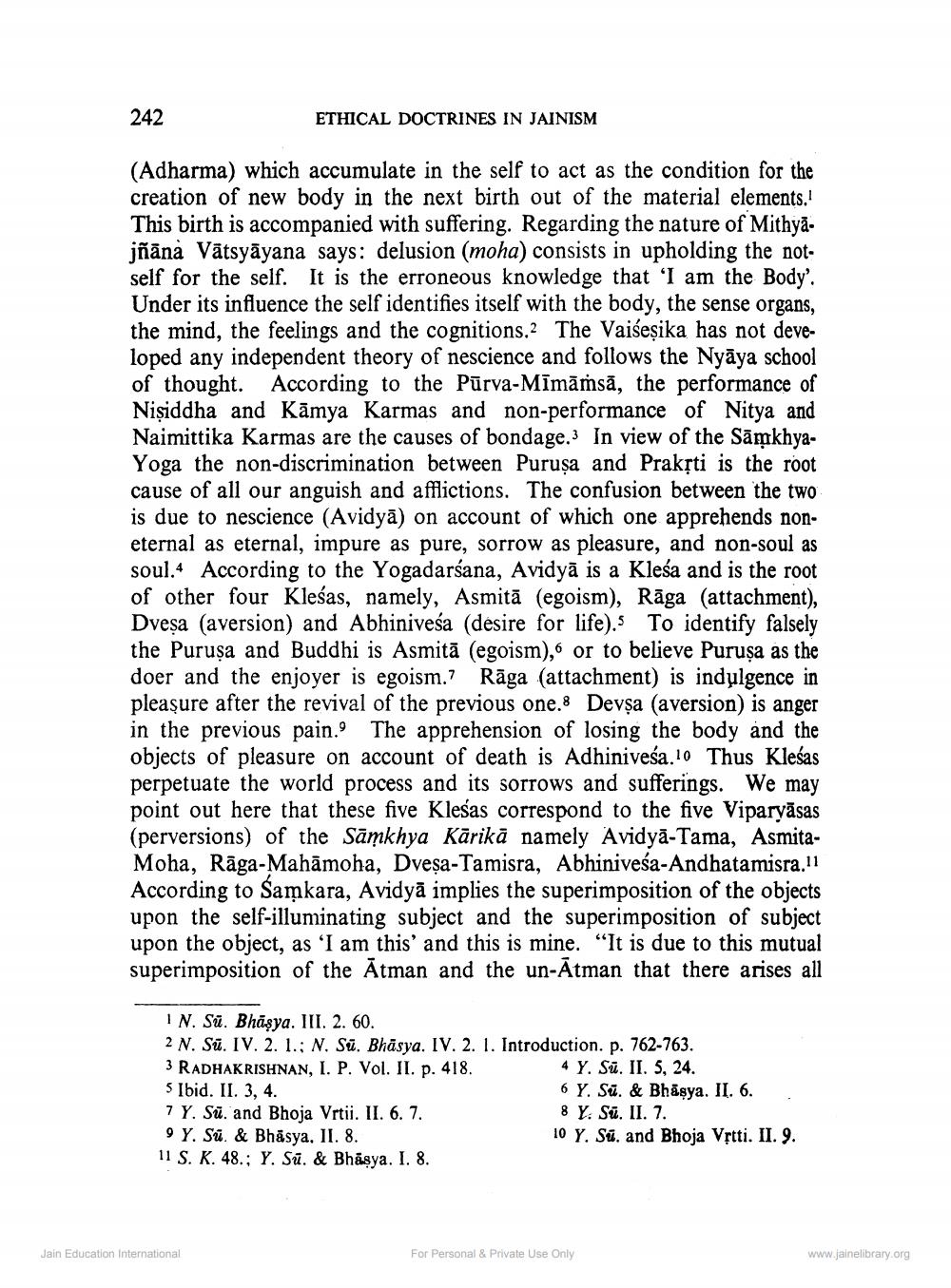________________
242
ETHICAL DOCTRINES IN JAINISM
(Adharma) which accumulate in the self to act as the condition for the creation of new body in the next birth out of the material elements. This birth is accompanied with suffering. Regarding the nature of Mithyā. jñāna Vātsyāyana says: delusion (moha) consists in upholding the notself for the self. It is the erroneous knowledge that 'I am the Body'. Under its influence the self identifies itself with the body, the sense organs, the mind, the feelings and the cognitions. The Vaiseșika has not developed any independent theory of nescience and follows the Nyāya school of thought. According to the Pūrva-Mīmāṁsā, the performance of Nişiddha and Kāmya Karmas and non-performance of Nitya and Naimittika Karmas are the causes of bondage.3 In view of the SāņkhyaYoga the non-discrimination between Purusa and Praksti is the root cause of all our anguish and afflictions. The confusion between the two is due to nescience (Avidyā) on account of which one apprehends noneternal as eternal, impure as pure, sorrow as pleasure, and non-soul as soul. According to the Yogadarśana, Avidyā is a Kleśa and is the root of other four Kleśas, namely, Asmitā (egoism), Rāga (attachment), Dvesa (aversion) and Abhinivesa (desire for life). To identify falsely the Puruşa and Buddhi is Asmitā (egoism), or to believe Purusa as the doer and the enjoyer is egoism.? Rāga (attachment) is indulgence in pleasure after the revival of the previous one.8 Devșa (aversion) is anger in the previous pain. The apprehension of losing the body and the objects of pleasure on account of death is Adhiniveśa.10 Thus Klešas perpetuate the world process and its sorrows and sufferings. We may point out here that these five Klesas correspond to the five Viparvāsas (perversions) of the Sāņkhya Kārikā namely Avidyā-Tama, AsmitaMoha, Rāga-Mahāmoha, Dvesa-Tamisra, Abhiniveśa-Andhatamisra.11 According to Samkara, Avidyā implies the superimposition of the objects upon the self-illuminating subject and the superimposition of subject upon the object, as 'I am this' and this is mine. "It is due to this mutual superimposition of the Ātman and the un-Ātman that there arises all
IN. Sü. Bhāsya. III. 2. 60. 2 N. Sū. IV. 2. 1.; N. Sú. Bhāsya. IV. 2. 1. Introduction. p. 762-763. 3 RADHAKRISHNAN, I. P. Vol. II. p. 418.
4 Y. Sū. II. 5, 24. 5 Ibid. II. 3, 4.
6 Y. Su. & Bhäsya. II. 6. 7 Y. Sū. and Bhoja Vrtii. II. 6. 7.
8 Y. Sū. II. 7. 9 Y. Sú & Bhäsya. II. 8.
10 Y. Sú. and Bhoja Vștti. II. 9. 11 S. K. 48.; Y. Sū. & Bhasya. I. 8.
Jain Education International
For Personal & Private Use Only
www.jainelibrary.org




